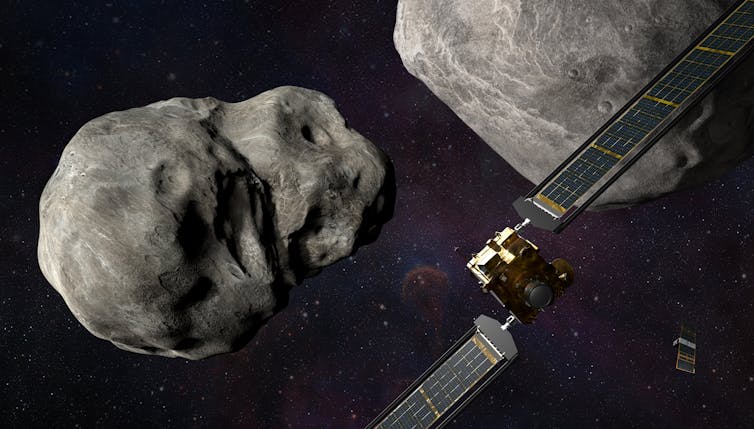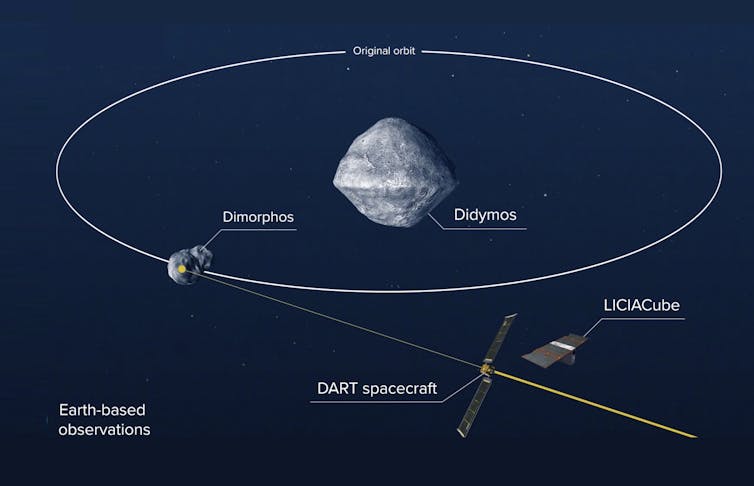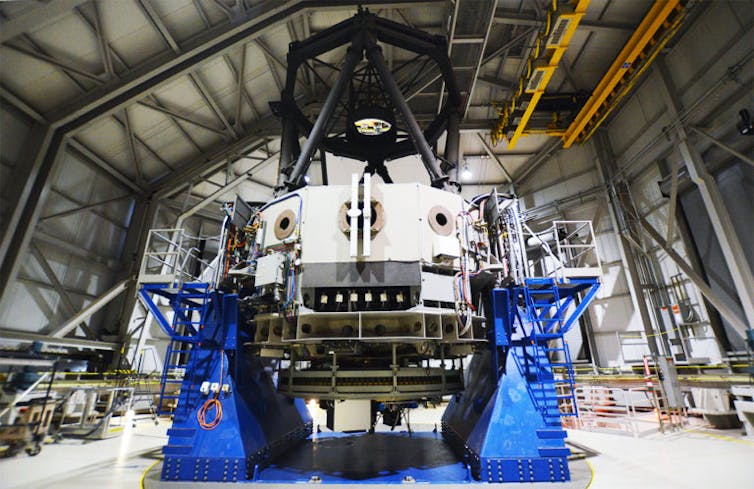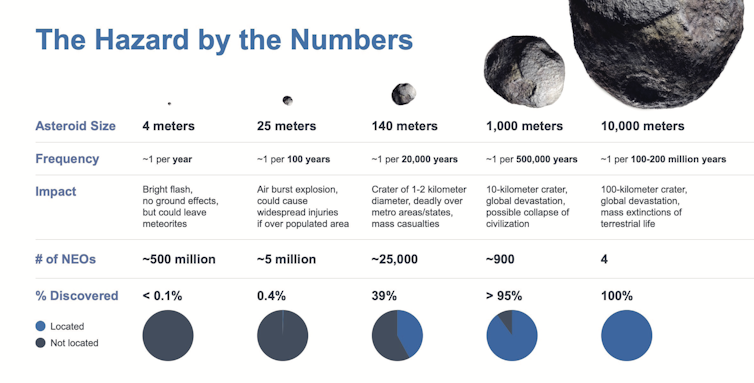

Illustration of DART in advance of affect.
NASA/Johns Hopkins APL/Steve Gribben
On September 26 at 11.15pm UTC, NASA’s DART mission (Double Asteroid Redirection Examination) will be the initial to deliberately and measurably change the movement of a considerable overall body in our Solar Procedure. In other text, it will smash into an asteroid.
The mission will deliver the very first exam of a system that could be employed in the foreseeable future – to redirect any asteroids we detect on a collision program with Earth.
A binary pair of house rocks
DART was launched on November 24, 2021, its vacation spot a pair of asteroids in orbit all around every other, 11 million kilometres from Earth.
The larger sized asteroid in the pair is known as Didymos and is 780 metres in diameter. The smaller sized asteroid, just 160 metres wide, is called Dimorphos. The two orbit each and every other at a length of 1.18 kilometres, and 1 orbit usually takes near to 12 hours.

NASA/Johns Hopkins APL
These asteroids pose no threat to Earth and have been preferred as the focus on for DART partly owing to that point. But also, importantly, since the asteroids form a binary pair, it will be doable for astronomers on Earth to evaluate the benefits of the impression.
As the asteroids orbit each individual other, the sunlight mirrored off them increases and decreases, different systematically above the 12-hour cycle of the orbit. Astronomers working with highly effective telescopes from Earth can observe this variation and see how it improvements, from right before to soon after the collision.
![]()
The physics is straightforward, the mission is not
The physics sounds straightforward, and it is. Hit a person factor with a further detail to modify its movement. But the mission execution is incredibly complex. When DART reaches the asteroids, it will be 11 million kilometres from Earth following a 10 thirty day period journey. The spacecraft has to use autonomous focusing on, applying visuals of the asteroids it acquires as it techniques.
DART desires to recognise the asteroids by by itself, mechanically lock on to Dimorphos, and adjust its trajectory to hit it. This is all whilst shifting at a speed of nearly 24,000 kilometres for each hour!
The benefits of the effects, when reasonably simple to evaluate, are hard to forecast. The dimension, form, and composition of Dimorphos, and just wherever DART hits and how tough, will influence the outcome.
All these components are uncertain to some diploma. Extensive laptop simulations of the affect have been carried out, and the comparisons of the simulations, predictions, and measured success will be the key outcomes of the DART mission.
As nicely as the measurements from telescopes on Earth, an up-shut view of the impression by itself will be achievable, from an Italian Area Agency CubeSat (a tiny variety of satellite) referred to as LICIACube that was deployed from a spring-loaded box aboard the craft on 11 September. LICIACube will comply with along and photograph the collision and its aftermath.

Lowell Observatory
The final results will convey to us a good deal about the nature of asteroids and our means to improve their motions. In the foreseeable future, this knowledge could be utilized to strategy planetary defence missions that search for to redirect asteroids deemed to be a danger to the Earth.
What is the level of menace?
An asteroid as modest as 25 metres in diameter could create injuries from an airburst explosion if it hit the environment in excess of a populated area. It is approximated that 5 million these kinds of objects exist in our Photo voltaic Procedure and that we have found out somewhere around .4% of them. These a hit is believed to occur as soon as every single 100 yrs. When rather frequent, the overall possibility is very low and the influence hazard is relatively minimal much too.
However, it is predicted there are 25,000 objects in the Solar Method the dimension of Dimorphos, 39% of which are recognised, that hit Earth just about every 20,000 years. These types of an object would lead to mass casualties if it hit a populated place.

NASA
Asteroids that could obstacle the existence of human civilisation are in the 1 km moreover sizing category, of which there are fewer than a thousand in the Photo voltaic System they could possibly strike Earth only every single 500,000 decades. We have presently identified 95% of these objects.
So, probable asteroid collisions with Earth variety from the repeated but benign to the extremely exceptional but catastrophic. The DART tests are becoming carried out in a incredibly appropriate and fascinating dimensions range for asteroids: people better than 100 metres.
If DART is successful, it might established the scene for foreseeable future missions that focus on asteroids, to nudge them out of the way of collisions with Earth. When an asteroid is a extended way from Earth, only a smaller nudge is essential to get it out of our way, so the before we can establish asteroids that are a probable risk, the much better.
In the in close proximity to foreseeable future, the nicely-worn premise of so several “an asteroid is coming, we need to deflect it!” flicks may well perfectly come to be a actuality.
Steven Tingay, John Curtin Distinguished Professor (Radio Astronomy), Curtin University
This article is republished from The Discussion under a Resourceful Commons license. Study the first article.




